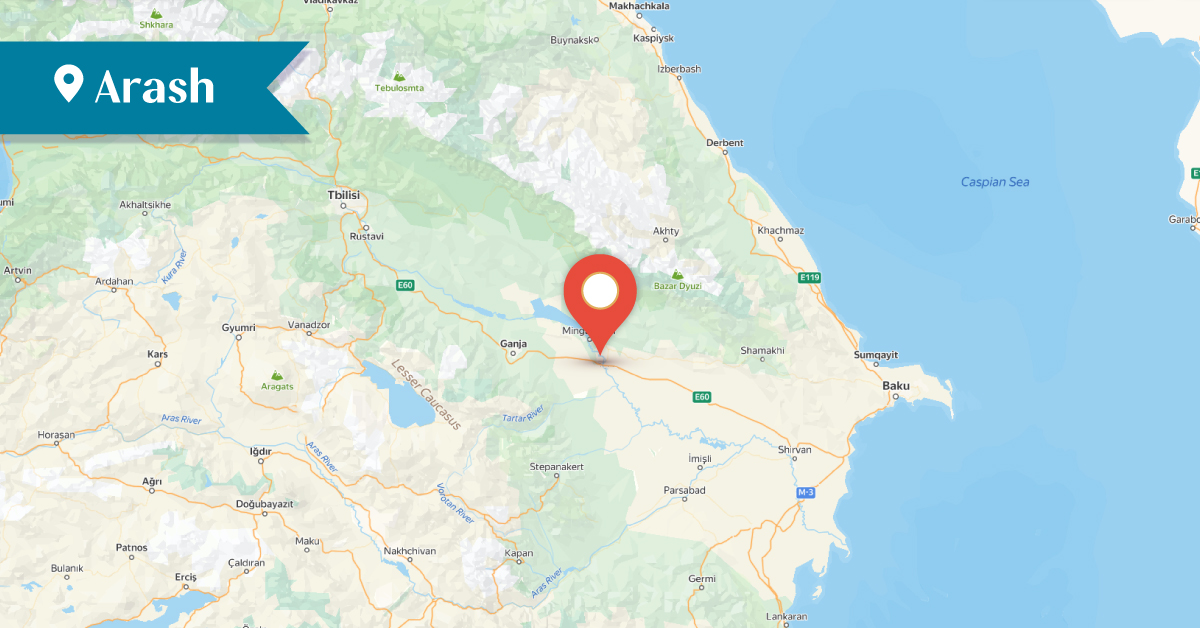2025
2025
2024-10-14

Armenians have inhabited the Eastern Transcaucasia region for centuries, with numerous villages populated exclusively by Armenians. However, in the 20th century, Azerbaijan’s genocidal policies forced the Armenian population to flee their ancestral homes or face annihilation. Azerbaijan has erased the region's rich Armenian historical and cultural heritage.
The town of Arash was notable among the Armenian settlements of Eastern Transcaucasia, where Armenians had settled as early as the Middle Ages. In the 15th-17th centuries, behind Shamakhi and Shaki, it was the third largest city on the left bank of the Kura River and one of the most important silk production centers in Transcaucasia. Local Armenians were also engaged in gardening and viticulture. In parallel with the city's name, Arash, it has long been called the Armenian Bazaar (Ermani Bazaar), which testifies to the fact that it was an Armenian settlement.
In 1279, the church of Saint Yeghishe was built in Arash, as evidenced by the stone inscription: “In the reign of the Catholicos Father Stepanos (of Aluank), remember the builder of the church, Father Hovhannes, his parents and brothers, in the year 1279”.
Father Hovhannes also built the church's narthex. “During the reign of Apagha khan and under the rule of Catholicos Father Stepanos, and during the rule of Noradin, Sradjadin, and Gurzadin, I, Father Hovhannes, built this narthex in memory of myself, my brothers, and my parents in 1284.”
According to the Gavazanagirk of Aghvank's catholicoi, Stepanos served as Catholicos from 1262 to 1323. The fact that an Armenian church was founded in Arash in the 13th century is evidence that it had a significant Armenian population.
Anthony Jenkinson, a renowned English traveler and merchant, who was in Shirvan in the early 1560s and also visited Arash, mentioned this city in his travelogue as a prosperous trading city.
In the 19th century, the settlement was part of the Aresh (or Arash) uyezd of the Elizavetpol governorate. In 1914, it was entirely populated by Armenians and had 323 inhabitants, while in 1917, it had 50 Armenian households. The village's population spoke the Aresh-Havarik dialect. In April 1918, the population of Arash was ordered to convert to Islam, but after the residents refused, the village was destroyed by Tatar raiders.
After the establishment of Soviet rule in Azerbaijan, the village was settled by Caucasian Tatars. The settlement is now part of the Yevlakh district of the Republic of Azerbaijan.
After the establishment of Soviet rule in Azerbaijan, the Church of Saint Yeghishe in Arash was destroyed, along with the local Armenian cemetery. Monumentalist Samvel Karapetyan found a 16th-century tombstone in the territory of the ruined ancient Armenian cemetery with the following inscription.
"Here rests Umur Khatun in the year 1563."
The second tombstone he discovered in the same cemetery dated back to the early 19th century.
"This tombstone of Arash...
Ter Karapetyan Ter of [Ba]zar...
in 1820."

These two tombstones, miraculously preserved in the Armenian cemetery of Arash at the end of the 20th century, were the unique testimonies that proved the Armenian presence.
It should be noted that Melkiseth of Arash, the Catholicos of Aghvank (Gandzasar), was from this settlement. According to the Gavazanagirq of the Catholicoi of Aghvank, he is mentioned as the abbot of Gandzasar Monastery in 1593.
Bibliography